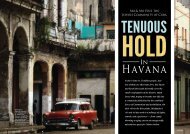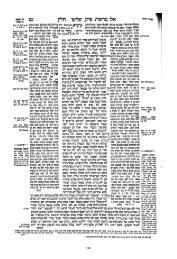The Matzah Of Uzbekistan - Halachic Adventures
The Matzah Of Uzbekistan - Halachic Adventures
The Matzah Of Uzbekistan - Halachic Adventures
You also want an ePaper? Increase the reach of your titles
YUMPU automatically turns print PDFs into web optimized ePapers that Google loves.
<strong>Uzbekistan</strong> Matzoh Making Unmasked<br />
<strong>Uzbekistan</strong><br />
matzoh<br />
makıng<br />
unmasked<br />
Quest<br />
mesor ah<br />
with<br />
ARI<br />
ARI<br />
Like other kehillos, Bukharan Jews had<br />
their own distinct ways of making matzos.<br />
Six weeks before Pesach, Ari and Ari set<br />
off for <strong>Uzbekistan</strong> to find out if the age-old<br />
secret had survived almost a century of<br />
Soviet rule — and if, of course, it was still<br />
possible to have a taste<br />
Text and Photos by Ari Greenspan and Ari Zivotofsky<br />
Out of sight and<br />
long forgotten an old<br />
matzoh oven lay hidden<br />
in a room overlooking this<br />
Samarkand courtyard<br />
66 MISHPACHA<br />
5 Nisan 5772 | March 28, 2012 MISHPACHA 67
<strong>Uzbekistan</strong> Matzoh Making Unmasked<br />
“In every generation and<br />
generation they arise to destroy us and Hashem saves us from their<br />
hands.” Although it was not yet Pesach, we were reminded of those<br />
words from the Haggadah before we set off for central Asia and a<br />
halachic adventure in <strong>Uzbekistan</strong>. A few days earlier an attack on<br />
the Israeli embassy in India heightened security concerns across<br />
the Jewish world; in this region that is uncomfortably close to Iran<br />
and Afghanistan those concerns were especially high, particularly<br />
among the Israeli diplomatic corps.<br />
However, our welcome to the country set the tone for the entire<br />
trip. We were greeted at the airport by our friend, the Israeli ambassador<br />
to <strong>Uzbekistan</strong>, who had come personally to pick us up. This<br />
was to be our experience throughout our stay — in every town the<br />
local Jews went above and beyond simple hachnassas orchim in their<br />
warmth and hospitality.<br />
But why go to <strong>Uzbekistan</strong> This backward country has been home<br />
to the community known as Bukharan Jews for many centuries,<br />
but as with so many out-of-the-way kehillos, many of its traditions<br />
are in danger of being forgotten. If we could not uncover and record<br />
all of those traditions there was at least one that we couldn’t<br />
pass over. That, of course, was the secret of their matzoh baking.<br />
Shalom, Samarkand <strong>Uzbekistan</strong>, a country with a rich ancient<br />
history, was one of the main stops on the Great Silk Road<br />
that brought precious commodities and wealth from China in<br />
exchange for European gold. Jews have lived there, according to<br />
some traditions, since the destruction of the First Temple in 586<br />
BCE. Some of the lost Ten Tribes of Israel were certainly exiled<br />
to this region, and the Jews of Bukhara, the <strong>Uzbekistan</strong> province<br />
that gave its name to the entire region’s kehillah, have been<br />
there since the Second-Temple period. Samarkand, the country’s<br />
second-largest city, has had a Jewish community for many<br />
centuries. Benjamin of Tudela, the 12 th -century Jewish explorer,<br />
described visiting Samarkand, which he called “a great city” in<br />
Persia, in which 50,000 Jews lived. <strong>The</strong> Jewish community was<br />
headed by a nasi — at the time of the Jewish explorer’s visit the<br />
nasi’s name was Rav Obadiah — and it included wise and very<br />
wealthy traders.<br />
For most of the 20 th century, <strong>Uzbekistan</strong> was part of the Soviet<br />
Union. Since the dissolution of the Soviet Union 20 years ago, <strong>Uzbekistan</strong><br />
has been an independent country whose population is more<br />
than 90 percent Muslim. However, the government, which keeps<br />
close control over the country, has made concerted efforts to keep<br />
out Muslim fundamentalism, including maintaining tight borders<br />
that prevent infiltrations from neighbors such as Afghanistan and<br />
Tajikistan. In addition, a recent law instituted by the country’s Muslim<br />
president bans muezzins in the mosques from using loudspeakers;<br />
thus, the calls to prayer are done modestly, as was done for centuries,<br />
by a person calling out from the mosque. All this has helped to create<br />
a stable and peaceful environment. In fact, we strolled with our<br />
yarmulkes showing everywhere, happy to respond to “salom alekem”<br />
with a congenial, “aleichem sholom.” When we discussed with some<br />
of the locals the cordial relationship between the Jews and Muslims,<br />
they told us that indeed the Muslims were familiar with the Jewish<br />
calendar, and when they noticed the weather changing in the spring,<br />
they would comment jovially to their Jewish neighbors that Pesach<br />
must be around the corner.<br />
We spent only one night in Samarkand, but it was an eventful one<br />
since we arrived on the eve of a traditional memorial service, which is<br />
known by the locals as a yushvo (a Judeo-Tajik term derived from the<br />
Hebrew yeshivah). Before our trip Professor Alanna Cooper of Boston<br />
University shared with us a chapter from her soon-to-be-published<br />
book Bukharan Jews and the Dynamics of Global Judaism, in which she<br />
makes an extremely perceptive and important observation regarding<br />
the yushvo. She had seen that many of the men in the synagogue were<br />
familiar with the davening and knew at which parts to respond and<br />
what actions to perform, yet it was clear that most of them didn’t say<br />
most of the words and certainly didn’t understand the actual content.<br />
This is not surprising when we remember that they lived under the<br />
repressive Soviet regime for close to 80 years, a time when there were<br />
no Jewish schools, when there was at most one official shul per town,<br />
and when any public display of religion was banned.<br />
How then do these Jews still know anything about formal ritual<br />
Prof. Cooper explains, “This sort of knowledge can only be taught<br />
and learned through modeling, watching, and interacting.” Where<br />
did this take place <strong>The</strong> Soviets were able to shutter and bulldoze the<br />
synagogues, but they couldn’t stop people from gathering in private<br />
homes for what appeared to be an extended family gathering yet<br />
was in fact a significant religious ritual. Davening therefore became<br />
intertwined with the yushvo, which was meticulously observed for<br />
every yahrtzeit and became an important part of these Jews’ social<br />
and religious life.<br />
Accompanied by our Hebrew translator, Tamara, we were led to<br />
F 1. F 2.<br />
1. FERGANA FRIENDS<br />
Ari G. (r) with Fergana’s<br />
shamash and Rabbi<br />
Birnbaum<br />
2. FAMILY HEIRLOOMS<br />
<strong>The</strong>se rimonim were<br />
just one example of<br />
<strong>Uzbekistan</strong>’s hidden<br />
treasures<br />
3. TZEDAKAH<br />
TRADITIONS A Bukharan<br />
shul’s tzedakah box<br />
4. FOOD FOR THOUGHT<br />
This centuries-old<br />
matzoh oven was used<br />
to store seforim<br />
F 3. F 4.<br />
F 2.<br />
F 3. F 4.<br />
68 MISHPACHA<br />
5 Nisan 5772 | March 28, 2012 MISHPACHA 69
<strong>Uzbekistan</strong> Matzoh Making Unmasked<br />
an unkempt courtyard in the old city of Samarkand, which led in turn<br />
to a small low-ceilinged room swathed in old Persian carpets. <strong>The</strong> only<br />
light came from a weak, naked lightbulb. Twelve men, almost all single<br />
or widowed, sat around tables arranged in a U shape, which were laden<br />
with drinks and pickled fruits and vegetables. <strong>The</strong> hot food, in huge<br />
quantities, was yet to come.<br />
<strong>The</strong> event is primarily for men, and on this night the lone woman<br />
present was Tamara, who sat in the back and helped in the kitchen<br />
when she wasn’t translating for us. This yushvo was smaller than what<br />
had been customary in the past, due to the small number of Jews left<br />
in Samarkand. However, the ritual was performed as it has been for<br />
centuries. <strong>The</strong> evening began with Minchah, followed by a series of<br />
readings that no one understood. Yet everyone participated, and even<br />
though most were without siddurim and couldn’t recite the davening,<br />
they stood and sat and gestured at the appropriate junctions. Our host<br />
then described his departed mother, whose hand-painted photograph<br />
was displayed prominently on the wall. At the end of the service Kaddish<br />
was recited.<br />
Due to its central role, in former times the yushvo was held not only<br />
on the yahrtzeit. During the shivah week it was a nightly event and during<br />
the year of mourning it was observed each month on the day of the<br />
month that the person had<br />
In the morning light<br />
we saw that the<br />
grandson had not<br />
misrepresented the<br />
situation. <strong>The</strong> only<br />
entry to the room was<br />
via a rickety wooden<br />
ladder, which we<br />
cautiously ascended<br />
died. During the Soviet era it<br />
was also held throughout the<br />
first month of mourning on<br />
the day of the week that the<br />
person had died. It may have<br />
not been a conscious way to<br />
hide religious activity from<br />
the Soviet government, but it<br />
was certainly effective since it<br />
became the method to transmit<br />
both prayer and the religious<br />
lessons that were included<br />
in the speeches that<br />
followed Minchah.<br />
<strong>The</strong> next day we were invited to speak to a group of about 50 potential<br />
olim at a Jewish Agency–sponsored afternoon tea. At this monthly<br />
event people eligible for aliyah get together to learn about Judaism, and<br />
the Land of Israel, and to understand the aliyah process. <strong>The</strong> event reminded<br />
us of the gatherings of the 1930s, about which we had read. Yet<br />
after our short talks, which were about Jewish history and halachah, a<br />
woman with a mouthful of gold teeth stood up and, in words that were<br />
part plea and part demand, implored us in Hebrew to have a rabbi and<br />
shochet sent to Samarkand. She said that is what they really want and<br />
they feel neglected by world Jewry. She was neither the first nor the only<br />
person we met during our stay who expressed such yearnings.<br />
Where’s the Matzoh <strong>The</strong>se first glimpses into the <strong>Uzbekistan</strong><br />
kehillah were moving, but they didn’t make us forget a<br />
<strong>Of</strong>f the beaten track:<br />
a matzoh oven found in<br />
the Fergana valley<br />
A Samarkand yushvo:<br />
both the memory of the<br />
deceased and memories<br />
of ancient traditions are<br />
kept alive<br />
prime reason we had come — the matzos. We knew there had been<br />
a unique tradition of matzoh baking in this part of the world, but<br />
when we asked the Israeli ambassador if we could observe it, his<br />
reply was discouraging. He told us that he had investigated the<br />
subject and that there had been one family in Bukhara that knew<br />
how to bake matzos in the Bukharan tradition, but they had moved<br />
to Brooklyn last year. Now there is nobody who knows.<br />
We were disheartened by this news until we recalled that, in the language<br />
of the Talmud, “Israel is not a widow.” <strong>The</strong>re is always somebody<br />
to carry on the tradition. We just had to find them.<br />
In the meanwhile, we felt like we were kids allowed to run about freely<br />
in a candy store, since there are so many opportunities in <strong>Uzbekistan</strong> to<br />
discover traditions and ritual artifacts. On the prior Motzaei Shabbos<br />
we found ourselves in the courtyard of a dwelling presently inhabited<br />
by three generations of one family. <strong>The</strong> walls of the family’s house were<br />
lined with photographs of previous generations of Torah-observant ancestors.<br />
That love for Torah can be found today in the family’s 23-yearold<br />
grandson, who has been serving as a functionary in the shul since<br />
his bar mitzvah and was the shaliach tzibur for many of the Shabbos<br />
tefillos when we were there. His grandfather had studied with a private<br />
rebbi during the Soviet era, until his rebbi was exiled to Siberia.<br />
<strong>The</strong> grandfather had inherited several religious items from his father,<br />
including rimonim for the Torah and an old Megillas Esther.<br />
After seeing these treasures, we asked if the family had any old tefillin.<br />
<strong>The</strong> grandson excitedly told us that of course they still had them and<br />
proceeded to fling open one old wooden cabinet after another. When he<br />
finally found them, the truth was that they excited us less than something<br />
else that we saw behind one of those doors. <strong>The</strong>re, in front of our<br />
eyes, was a stash of unique Bukharan matzoh-baking equipment that<br />
had been used for generations. It hadn’t dawned on him that those old,<br />
simple implements would interest us.<br />
We excitedly asked him to explain how each tool was used, and<br />
he readily sold us a few of the “reddlers” (hole makers) and pans<br />
that were among the finds. It seems that in the previous generation,<br />
when the region was overflowing with Jews, every family baked<br />
their own matzoh and thus they all had the necessary equipment.<br />
An old adage says that there is no smoke without fire. We therefore<br />
deduced that there are no matzoh-baking implements without a matzoh<br />
oven being nearby. So where was it <strong>The</strong> grandson told us that<br />
the oven, which was built into a wall, was located in an upstairs room.<br />
Sensing our excitement, he then added that not only was the room<br />
virtually inaccessible but there was no light in it, making a nighttime<br />
visit impossible.<br />
<strong>The</strong> next day we returned to the family’s home. In the morning light<br />
we saw that the grandson had not misrepresented the situation. <strong>The</strong><br />
only entry to the room was via a rickety wooden ladder, which we cautiously<br />
ascended. Unfortunately, the oven was no longer intact, but the<br />
search for it turned out to be not an entirely futile investment. Sitting<br />
inside what had been a matzoh oven for well over a hundred years was<br />
a huge stack of old seforim. We knew from experience that despite their<br />
70 MISHPACHA<br />
00 Month 0000 | Month 00, 0000<br />
5 Nisan 5772 | March 28, 2012 MISHPACHA 71
F 1.<br />
1. MATZOH MAKING,<br />
UZBEKI/PERSIAN<br />
STYLE Rolling out<br />
the dough<br />
2. READY FOR THE<br />
REDDLER <strong>The</strong> dough<br />
is perforated using<br />
the family’s antique<br />
reddler<br />
3. TASTE OF<br />
TRADITION<br />
<strong>Uzbekistan</strong><br />
matzoh<br />
age — most were as old, if not older than the oven — they probably weren’t<br />
of interest, being run-of-the-mill siddurim and Chumashim. However, we<br />
bought them and when we got home we were delighted to discover that one<br />
was an older, rare printing of the Shulchan Aruch.<br />
By Hand and Lishmah Today there are very few Jews who live<br />
outside the main cities, but one of the small communities still left in<br />
the countryside can be found in the distant valley of Fergana. <strong>The</strong>re are<br />
only about 30 Jews left in the village of Fergana, yet they still manage to<br />
have a minyan on most Shabbosim.<br />
When we arrived, the entire community came to welcome us. Tourists almost<br />
never come to this place that is truly off the beaten track, and we were moved<br />
by how happy and honored they felt that we had come to visit them. After we<br />
shechted some birds and gave a little talk, we asked if they had any questions.<br />
While their questions might seem basic to us, these devout but not knowledgeable<br />
Jews were very unsure and concerned about if they should take the Torah<br />
out of the ark if there was no minyan. Could they even open the aron kodesh<br />
After clarifying that topic for them, they, like Jews elsewhere in the country,<br />
complained bitterly about not having the shochet visit regularly, like in the old<br />
days. Since it was just six weeks before Pesach, they begged for help with obtaining<br />
matzoh. In previous years their matzoh had been provided by the American<br />
Joint Distribution Committee, but they claimed it had not come the year before.<br />
We immediately called our contacts at the AJDC office in Israel, who assured<br />
us that a large supply of matzoh and wine was being sent in time for the holiday.<br />
After we left the group, we paid a visit to the home of the one person in the<br />
village who spoke Hebrew. He was in his 30s and lived with his<br />
parents; his father was the shamash in the shul. When queried<br />
about matzoh, they too showed us their family’s matzoh<br />
equipment.<br />
In this part of the world, the wheat set aside for baking matzoh<br />
was often kept in a locked closet until it was time to grind it. <strong>The</strong><br />
grinding was all done by hand and lishmah, so that the matzos<br />
would properly fulfill the mitzvah. What is unusual about their<br />
custom is that the Persian communities, of which the Bukharan<br />
Jews can be counted, would roll out very, very large matzos on<br />
F 3.<br />
the back of huge Persian metal pans. Traditionally this work was<br />
done by the women while sitting on the floor. When we asked<br />
about the oven, they told us they use a traditional Uzbeki bread<br />
oven that had been kashered. <strong>The</strong>y then proceeded to take us<br />
to a Muslim courtyard to see one.<br />
We knew that Iranian matzos, which are baked daily, are<br />
soft. We were therefore very surprised when the family told<br />
us that according to their memories their locally made matzos<br />
had been hard and were all made a week or so before Pesach.<br />
Was this perhaps an instance where the older traditions were<br />
lost during the long years of Soviet oppression<br />
A Taste, At Last While in Samarkand, we were able to get<br />
our hands on what we had been looking for. Nina, one of our<br />
hosts, graciously took us to a room in her home and showed us<br />
her great-grandmother’s matzoh-baking instruments.<br />
After we pleaded that seeing the<br />
implements wasn’t enough, she consented to<br />
demonstrate the matzoh-making process.<br />
First she took a very old metal bowl and<br />
put in the flour. Next, she grasped a large,<br />
hand-forged sort of soup ladle, which was<br />
clearly between 100 to 200 years old. Her<br />
great-grandmother had used this ladle for<br />
only one purpose — to pour the mayim shelanu<br />
(the special water that had been kept<br />
overnight and was used to make matzoh) onto<br />
the flour that had been kept under lock and<br />
key until it was time to bake her matzos.<br />
After rolling out the dough on a smallish<br />
pan, due to the size constraints of Nina’s modern<br />
gas oven, we used her great-grandmother’s<br />
rusty old reddler to make the holes so that<br />
the dough wouldn’t rise. <strong>The</strong> dough was then<br />
baked in Nina’s modern oven, but she insisted<br />
that, other than its smallish size, the matzoh<br />
was exactly what their traditional matzoh<br />
looked and tasted like: It was very thin and<br />
crispy and quite tasty. From an old wives’<br />
tale that we were told, it is clear that they too<br />
used to pine for the taste of matzoh. We are<br />
all familiar with the Yerushalmi’s injunction<br />
against eating matzoh on Erev Pesach, which<br />
in some families now extends back to Rosh<br />
Chodesh Nisan or even Purim. While our<br />
tradition offers no consequence of violating<br />
the prohibition, the Bukharans told us that<br />
in their tradition, if one ate matzoh on Erev<br />
Pesach, all their teeth would fall out!<br />
Our journey to <strong>Uzbekistan</strong> has ended, yet<br />
we both agree that eating matzoh on Leil<br />
Seder will now have an added depth of meaning.<br />
While today obtaining matzos is easy<br />
for most of us, for our ancestors, fulfilling<br />
the mitzvah of matzoh required great effort<br />
and energy. But it was baked with so much<br />
care, love, and devotion that every generation<br />
fondly recalled both the taste and the<br />
process, and passed on those memories to<br />
those who came after them. For no matter<br />
where they lived and what difficulties they<br />
faced, every year each kehillah and eidah<br />
sanctified Pesach by making kosher matzos<br />
according to their precious traditions and<br />
unique customs. —<br />
F 2. F 3. 5 Nisan 5772 | March 28, 2012<br />
72 MISHPACHA


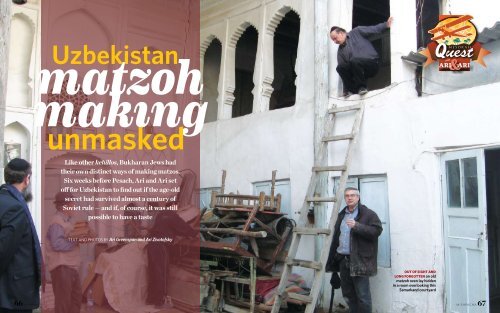

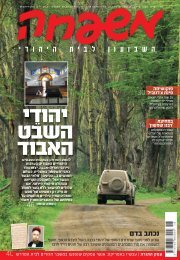




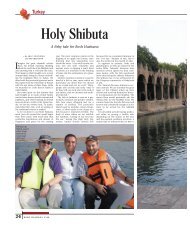
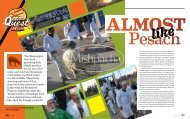


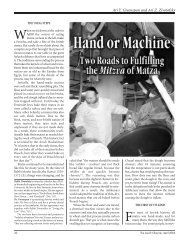
![llVtlwnl 1p1l 1biip 3 K11lnM o1it1 [1] - Halachic Adventures](https://img.yumpu.com/35271577/1/190x253/llvtlwnl-1p1l-1biip-3-k11lnm-o1it1-1-halachic-adventures.jpg?quality=85)
